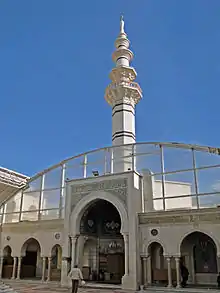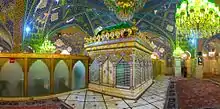Ruqayyah bint Husayn
Ruqayyah bint Al-Ḥusayn[2] (Arabic: رُقَيَّة بِنْت ٱلْحُسَيْن, born on the 20th of Rajab, 56 AH – 5 Rabi' al-Thani, 60 / 61 AH or 676 CE; died on the 13th of Safar, 60 / 61 AH or 680 / 681 CE),[1] was the daughter of Husayn ibn Ali and Rubab bint Imra al-Qais.[3] Her brothers included Ali Zayn al-Abidin, Ali al-Akbar, and Ali al-Asghar. Her sisters included Fatimah as-Sughra and Fatimah al-Kubra, with the latter also being called 'Sakinah'.[4][5][6][7][8]
Ruqayyah ibnat Al-Husayn رُقَيَّة بِنْت ٱلْحُسَيْن | |
|---|---|
 | |
| Born | 20 Rajab, 56 AH (676 CE) |
| Died | 13 safar, 60 / 61 AH (680 / 681 CE)[1] Damascus, Shaam |
| Parents |
|
Narrative
.jpg.webp)
The story of Ruqayya is one of the many emotional stories that Muslims tell about Husayn and his martyrdom at the hands of Yazid's troops. The Battle of Karbala and the subsequent events at the court of Yazid are explained and mourned annually during the commemoration of the 10th of Muharram, also known as "'Ashura'".
Journey to Iraq and Shaam

She accompanied her father when he traveled from Mecca to Kufah in Iraq. On the 2nd of Muharram, 61 AH (680 CE), Husain and 72 of his family members and companions were forced to camp in the plains of Karbala by Yazid's army of 30,000 men. Yazid ibn Muawiyyah was the practical Caliph who desired religious authority by obtaining the allegiance of Husain, but the Imam would not give up his principles. On the 10th of Muharram, the Imam's household was attacked, a number of his companions were killed, and the survivors were made captives. The survivors included the Imam's sisters, wife, and daughters, including Sukayna, relatives of companions of the Imam, and his son, Ali Zaynul-Abidin, who did not participate in the battle, due to an illness. Sukayna, as with others, had been grieved over the killings. They had also suffered from thirst.[9]
The survivors were marched by Yazid's army from Karbala to Kufah, where Sukayna received water from a sympathetic woman, and then to Damascus in Shaam. There was a lack of pity from the captors' part during the journey. Even at these times of hardship and misery, Ruqayyah was sympathetic to others, such as her mother, whom she consoled her mother on the death of Ali al-Asghar.[9][10][11]
Mosque
According to Shia Islamic narrations that are commemorated every year on the occasion of Ashura, after enduring the Battle of Karbala and the torturous journey to Damascus that followed it, Sukaynah died at the age of four weeping over her father's head in Yazid palace hall where prisoner were initially stayed and, her body was originally buried at nearby site. Centuries later, an ʿĀlim (Arabic: عَالِم, Scholar) had a dream in which Sukayna asked him to move her body from the grave to another site, due to water pouring into her grave. He and some people opened the grave, and saw that ground water was indeed entering the grave, besides that her body was still intact. Sukayna's body was moved from its original burial place, the dungeon, and reburied where her Mosque is now located.[12][13]
The mosque was built around the mausoleum in 1985 and exhibits a modern version of Iranian architecture, with substantial amount of mirror and gold work. There is a small mosque area adjoining the shrine room, along with a small courtyard in front. This mosque is found a short distance from the Umayyad Mosque and the Al-Hamidiyah Souq in central Damascus.
- Sayyidah Ruqayya Mosque
 View of the courtyard
View of the courtyard Prayer hall
Prayer hall Grave of Sayyidah Ruqayyah
Grave of Sayyidah Ruqayyah A chandelier in the mosque
A chandelier in the mosque
 The zarih with a chandelier over
The zarih with a chandelier over Name board on the mosque
Name board on the mosque
Family tree
| Part of a series on Islam Shia Islam |
|---|
 |
|
|
| Adam | |||
| Nuh (Noah) | |||
| Ibrahim (Abraham) | |||
| Isma'il Ishmael | Is-haq (Isaac) | ||
| 'Adnan (b.122 BC)
. . . . . . |
Ya'qub (Jacob) | ||
| 'Abd al-Mutallib | 'Isa (Jesus) | Musa (Moses) | |
| 'Abdullah (d.570 AD) | Abu Talib (d.620 AD) | ||
| Muhammad (d.632 AD) | |||
| Fatimah (d.11 AH) | ʿAli (d.661 AD) | ||
| Al-Husain (d.680 AD) | |||
| Sakinah / Ruqayyah (d.680 AD)[14] | |||
See also
- Adnanites
- Arabs
- Banu Hashim
- Family tree of Husayn ibn Ali
- Fatimah bint Muhammad
- Fatimah bint Musa
- Quraysh
- Sayyidah Ruqayyah of Cairo
- Semite
- Umm ʿAmmar Sumayyah bint Khayyat, wife of Yasir ibn ʿAmir ibn Malik al-ʿAnsi
- Yahya ibn Zakariyya
References
- "3". Nafasul Mahmoom. Qum: Ansariyan Publications. 2005. pp. 388–389.
- Arne, Ambros; Stephan, Procházka (2004). A Concise Dictionary of Koranic Arabic. Wiesbaden: Ludwig Reichert Verlag. p. 136. ISBN 3-89500-400-6.
- Shaykh Abbas Qummi. Nafasul Mahmoom. p.298.
- Ihic.org Archived October 16, 2009, at the Wayback Machine
- Shia.org Archived March 1, 2009, at the Wayback Machine
- "(A.S.) Network". Imamreza.net. Retrieved 2015-07-02.
- Fortunecity.org Archived February 21, 2009, at the Wayback Machine
- "The Role of Women in Karbala". Alimoula110.com. Retrieved 2015-07-02.
- Coej.org Archived February 14, 2011, at the Wayback Machine
- "The Fourth Journey – Kufa to Shaam | The Journey of Tears | Books on Islam and Muslims". Al-Islam.org. 2013-10-28. Retrieved 2015-06-02.
- Nafs ul Mahmoom by Sheikh ‘Abbas Qummi, Behar ul Anwaar, Vol I by ‘Allamah Sayyad Mohammad Baqir Majlisi and others.
- 'Summary of the Tragedy of Sayyeda Ruqayya', Booklet at Ruqayya Mosque, 2008
- "Syria". Mailviruskid.tripod.com. Retrieved 2016-10-14.
- "ʿALĪ B. ḤOSAYN B. ʿALĪ B. ABĪ ṬĀLEB". ENCYCLOPÆDIA IRANICA. Retrieved 1 August 2011.
Bibliography
- Momen, Moojan An Introduction to Shi'a Islam, Yale University Press, 1985.